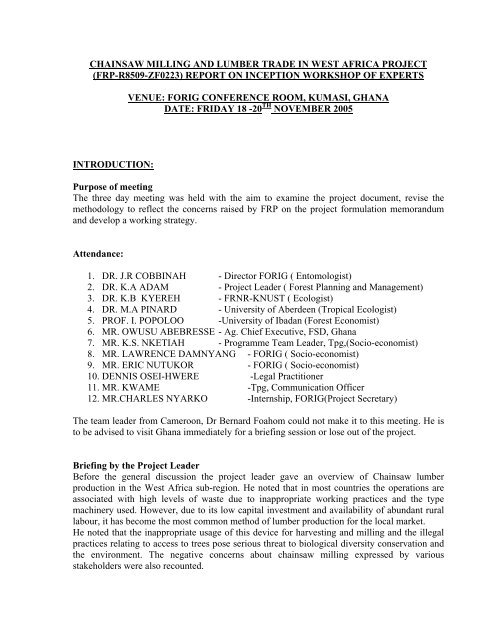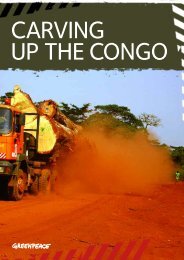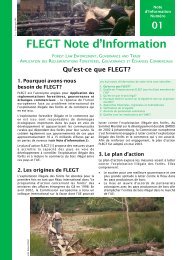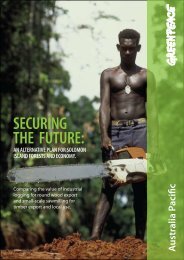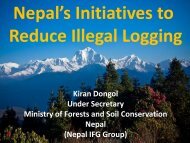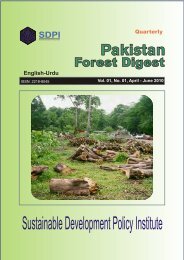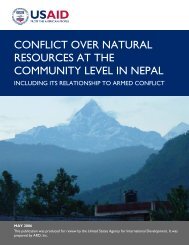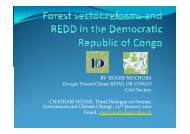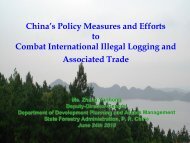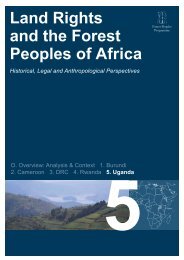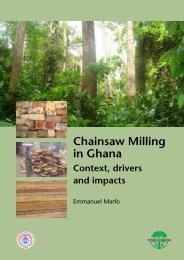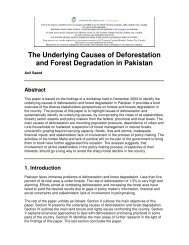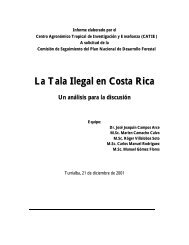chainsaw milling and lumber trade in west africa project
chainsaw milling and lumber trade in west africa project
chainsaw milling and lumber trade in west africa project
Create successful ePaper yourself
Turn your PDF publications into a flip-book with our unique Google optimized e-Paper software.
OUTPUT 1A decision support system that <strong>in</strong>dicates where <strong>and</strong> when <strong>in</strong> the West Africa <strong>cha<strong>in</strong>saw</strong>logg<strong>in</strong>g <strong>and</strong> <strong>cha<strong>in</strong>saw</strong> <strong>mill<strong>in</strong>g</strong> are appropriately (socially, economically <strong>and</strong> ecologically)developed;Activity 1.2 is to have a timeframe of two weeks, with<strong>in</strong> which the socio-economists <strong>and</strong>ecologists are to evaluate the social, economic <strong>and</strong> ecological impacts of <strong>cha<strong>in</strong>saw</strong> logg<strong>in</strong>g <strong>and</strong><strong>mill<strong>in</strong>g</strong> as compared to traditional <strong>in</strong>dustrial logg<strong>in</strong>g <strong>and</strong> fixed-saw <strong>mill<strong>in</strong>g</strong>. The lawyer <strong>and</strong>policy expert <strong>in</strong> the team they should also exam<strong>in</strong>e the legal, policy <strong>and</strong> regulatory provisionsthat govern access to legal <strong>and</strong> illegal timber <strong>and</strong> the constra<strong>in</strong>ts to their implementation.For activity 1.3 the resource economist should ensure that quantitative description of thenational annual <strong>lumber</strong> production by the <strong>cha<strong>in</strong>saw</strong> outfits <strong>and</strong> traditional sawmills areadequately provided for Cameroon <strong>and</strong> Ghana.A three member work<strong>in</strong>g team developed a structured questionnaire for this activity (SeeAnnex1-4). University of Aberdeen is to review the experimental design <strong>and</strong> protocols for dataanalysis. As part of the activity a frame work for data analysis <strong>and</strong> <strong>in</strong>terpretation should bedeveloped with<strong>in</strong> a week by the University of Aberdeen. To ensure the completion of theactivity on schedule regular work<strong>in</strong>g meet<strong>in</strong>gs are to be convened by team leaders <strong>in</strong> eachcountry to review <strong>in</strong>formation collated. The annotated bibliography should help to underst<strong>and</strong>the ma<strong>in</strong> factors <strong>in</strong>fluenc<strong>in</strong>g the social, economic <strong>and</strong> ecological susta<strong>in</strong>ability of <strong>cha<strong>in</strong>saw</strong>timber production <strong>in</strong> the various countries.This activity will be concluded with discussion sem<strong>in</strong>ars to be held at the three respectivehome countries. This is expected to come off <strong>in</strong> the second week of January 2006 after a focusgroup discussion to be held <strong>in</strong> December, 2005.OUTPUT 2An assessment of the structure <strong>and</strong> characteristics of corruption that underm<strong>in</strong>es theregularization of <strong>cha<strong>in</strong>saw</strong> timber production <strong>and</strong> equitable distribution of benefits <strong>and</strong>identification of anti-corruption tools that could be used to control timber harvest <strong>and</strong><strong>cha<strong>in</strong>saw</strong> <strong>mill<strong>in</strong>g</strong>With a competent activity leader, the structure of corruption <strong>in</strong> the forestry sector generally isto be described. This should be done first through the identification of all potentialstakeholders.To facilitate the characterization of corruption <strong>and</strong> selection of anti-corruption tools for theforestry sector, certa<strong>in</strong> key <strong>in</strong>stitutions like Ghana Institute of Manpower <strong>and</strong> Adm<strong>in</strong>istration(GIMPA), Transparency International (TI), are to be brought on board.
Activity report should be produced <strong>and</strong> dissem<strong>in</strong>ated by 16 th December 2005. Corruption toolkits developed should be publicised through the various media. Advertisements are to be<strong>in</strong>cluded <strong>in</strong> the dissem<strong>in</strong>ation strategy.OUTPUT 3Provide guidance on the transition from current state necessary <strong>and</strong> sufficient for <strong>cha<strong>in</strong>saw</strong>logg<strong>in</strong>g <strong>and</strong> <strong>mill<strong>in</strong>g</strong> to be legalized.The activities under this output are essentially to be carried out by the core team members fromthe three participat<strong>in</strong>g countries. The team should congregate <strong>in</strong> Ghana for the work<strong>in</strong>gmeet<strong>in</strong>g. Relevant stakeholders <strong>and</strong> policy makers are to be consulted through personalcontacts, telephone calls <strong>and</strong> by e-mails. A possibility of hold<strong>in</strong>g radio conferenc<strong>in</strong>g should beconsidered.It is agreed that, s<strong>in</strong>ce the <strong>project</strong> has a trans-boundary implications, it should be given a widerpublicity by not limit<strong>in</strong>g participation <strong>in</strong> the end of <strong>project</strong> sem<strong>in</strong>ar to only partner countries,but also <strong>in</strong>vit<strong>in</strong>g key Forestry, Environmental, Agriculture <strong>and</strong> Judicial officers, as well aslegislature from other West African countries with high forest. In this case, the <strong>project</strong> couldtake care of their board<strong>in</strong>g <strong>and</strong> lodg<strong>in</strong>g while their home organizations pay for their travell<strong>in</strong>gcost. This sem<strong>in</strong>ar is expected to take place fro the 19 th -20 th January 2006.A half-day dissem<strong>in</strong>ation workshop should be held latest 31 stparticipat<strong>in</strong>g countries.January 2006 <strong>in</strong> the three
OUTPUT123TABLE 1: SCHEDULE OF ACTIVITIES AND RESPONSIBILITIACTIVITY1.11.21.31.41.51.6(a)-Focus Group1.6(b)- All Groups1.71.82.12.22.33.13.23.3TIME FRAME ACTIVITY LOCATION AND LEADER(Completed By) UA CAMEROON GHANA NIGERIA18 th Nov. --K A Adam30 th Nov.To be provided K A Adam10 th DecTo be provided L Damnyag23 rd Nov. M A P<strong>in</strong>ardL Damnyag12 th Dec.Meet<strong>in</strong>g <strong>in</strong> Ghana31 st DecTo be provided K A Adam14 Jan 06To be provided K A AdamFebruaryK A Adam3 rd Wk Jan 06K A Adam16 Dec 0516 Dec 0514 Jan 0611 th Jan 0620 th Jan 06February 06M A P<strong>in</strong>ardMAPM A PTo be provideBFBFK S NketiahK S NketiahK A AdamWork<strong>in</strong>g met<strong>in</strong>g <strong>in</strong>Ghana-KAD/LP/BFKAD-To be providedTo be providedTo be providedTo be providedTo be providedTo be providedTo be providedTo be providedLPLP
METHODOLOGIES:Sampl<strong>in</strong>g Sites for field studiesFor possible variation <strong>in</strong> ecological impact due to <strong>cha<strong>in</strong>saw</strong> <strong>mill<strong>in</strong>g</strong> it was noted that samplesites should be based on the ma<strong>in</strong> forest types <strong>in</strong> each country. So field studies must beconducted <strong>in</strong> all the various ecological zonesNIGERIA: In the light of the variation <strong>in</strong> federal <strong>and</strong> state laws govern<strong>in</strong>g <strong>cha<strong>in</strong>saw</strong> <strong>lumber</strong><strong>and</strong> the variation <strong>in</strong> environmental impact due to vegetation type, the study will be carried out<strong>in</strong> the south/<strong>west</strong>, savannah <strong>and</strong> the Cross River State to give a fair representation of vegetationtypes <strong>and</strong> state laws some of which allow or disallow cha<strong>in</strong>-saw<strong>in</strong>gGHANA: The field studies will be carried out <strong>in</strong> Kade, Techiman, Goaso <strong>and</strong> Nkawie forestDistrict. These areas have vary<strong>in</strong>g records of illegal timber <strong>and</strong> <strong>cha<strong>in</strong>saw</strong> <strong>mill<strong>in</strong>g</strong> operations.For <strong>in</strong>stance Techiman serves as exist for movement of timber to the savannah zones <strong>and</strong> theSahelian countries of Bourk<strong>in</strong>a Faso, Mali <strong>and</strong> Niger. Kade district is notorious for illegallogg<strong>in</strong>g.CAMEROON: ABSENT. The <strong>project</strong> leader is to contact him as soon as possible.BUDJECT:It was presumed that s<strong>in</strong>ce FORIG is the ma<strong>in</strong> client to the contractual agreement with DFID, itis expected that a sub-contract will be signed between FORIG <strong>and</strong> the other collaborators.Clarification <strong>and</strong> further directives on this issue has to be sought from NRI. If this presumptionproves to be the case then we should expect delays <strong>in</strong> the transfer of funds to the othercollaborators. In event of this situation collaborators should work out local arrangements topre-f<strong>in</strong>ance the activities especially s<strong>in</strong>ce we are work<strong>in</strong>g aga<strong>in</strong>st time.CONCLUSION:Cha<strong>in</strong>saw operation needs to be regularized to ensure optimum benefit to all segments ofsociety. It is a requirement for all stakeholders to put fore their expertise to see this problemresolved.
ANNEX 1: {DRAFT}Household Survey Questionnaire for <strong>cha<strong>in</strong>saw</strong> <strong>and</strong> saw <strong>mill<strong>in</strong>g</strong>Name of enumerator________________________________IntroductionGeneral <strong>in</strong>formation1. Name of district2 Name of village/community3 Name of head of household4 Household number5 Name of respondent6. Family <strong>in</strong>formationNameRelationshipwith H/HAgeWorkawayfromhomeSexEducationPrimaryOccupationHow longhave youbeen<strong>in</strong>volved <strong>in</strong>this activityAnnual<strong>in</strong>comefromprimaryoccupationGender Code: Male ….1, Female…2Education code: Primary…1, Middle school…2, JSS..3, Secondary…4, JSS…5, SSS…6, Tertiary….7,University…8Primary occupation Code: agriculture…..1, hunt<strong>in</strong>g…2, timber…3, laborer…….4
No Questions <strong>and</strong> filters Cod<strong>in</strong>g categories SkipHousehold attributes7 Are you a native or settler <strong>in</strong> thisvillage/communitya. nativeb. settler farmer8 Before your primary occupation <strong>in</strong> Q 6 what didyou do previously9 How did you enter your present primaryoccupation <strong>in</strong> Q6c. other ( specify)a. farm<strong>in</strong>gb. trad<strong>in</strong>gc. tapp<strong>in</strong>ga. Own volitionb. through family memberc. through someone <strong>in</strong> thecommunityd. Learn<strong>in</strong>g through observation<strong>and</strong> trial <strong>and</strong> error.10 What type of experience have you (or anyone <strong>in</strong>your household?) had with <strong>cha<strong>in</strong>saw</strong> logg<strong>in</strong>g<strong>and</strong> <strong>lumber</strong><strong>in</strong>g11 Have you (or anyone <strong>in</strong> your household) hadany experience with large scale logg<strong>in</strong>g <strong>and</strong>/ or<strong>mill<strong>in</strong>g</strong> companya. No experienceb. <strong>lumber</strong> carrier/porterc. Transporterd. Saw operatore. Lumber millerf. Cha<strong>in</strong>saw ownerg. Cha<strong>in</strong>saw mechanich. Othersa. logg<strong>in</strong>g companyb. Mill<strong>in</strong>g companyc. NoneAssets12 What type of l<strong>and</strong> do you own/ work on a. Farm l<strong>and</strong>b. Forest l<strong>and</strong>c. Fallow l<strong>and</strong>d. L<strong>and</strong> for build<strong>in</strong>ge. Sacred growthf. Others13 How much l<strong>and</strong> do you own / work on14 What work equipment do own a. <strong>cha<strong>in</strong>saw</strong>b. tractorc. vehicled. othersIndicate other livelihood assets that you have……a. cattleb. goat <strong>and</strong> sheepc. birds/fowlsd. rabbitse. corn milld. shop15 Do you have access to loans (f<strong>in</strong>ancialassets/credits)a. Yesb. No
Social network16 Which associations or groups do you belong to a. Farmers associationb. Cha<strong>in</strong>saw operators associationc. Cooperative credit unionWhich traditional associations do youbelong to17 Do you (or does anyone <strong>in</strong> your household)participate <strong>in</strong> local governmenta. church associationb. Youth associationc. othersa. Yesb. NoHow closed are you to the assembly man <strong>in</strong>your communityHow about the chief, how closed are you to him18 Is there any company do<strong>in</strong>g logg<strong>in</strong>g <strong>in</strong> theforest near youa. Closeb. Not closec. Not on good termsd. Formal relation shipa. relativeb. closec. not closed. Not on good termsBenefits from large scale logg<strong>in</strong>g <strong>and</strong> <strong>mill<strong>in</strong>g</strong>a. Yesb. No19 Do you or any one <strong>in</strong> your household participate<strong>in</strong> this company logg<strong>in</strong>g activitya. Yesb. No20 If yes <strong>in</strong> 23, what role do you or yourhousehold member playa. skidder operatorb.21 If yes <strong>in</strong> 23 how are you employed a. Permanent employeeb. Casual laborer22 How much do you earn <strong>in</strong> this activity per monthper year23 What benefits does your household derive fromlarge scale logg<strong>in</strong>g activities <strong>in</strong> your areaa. employmentb. Social amenities (school, road,toilet, cl<strong>in</strong>ic, etc)c. Wood residued. Access to sawn timbere. Use of forest roadsf. Transportation on contractor’svehiclesg. othersCosts associated with the activities of large scale logg<strong>in</strong>g <strong>and</strong> <strong>mill<strong>in</strong>g</strong> near thevillage24 What costs or disadvantages does yourhousehold bear due to hav<strong>in</strong>g large scalelogg<strong>in</strong>g <strong>and</strong> <strong>mill<strong>in</strong>g</strong> <strong>in</strong> your areaa. Conflicts,b. damage to crops,c. accidentsd. pollution (health)e. forest degradation
25 Indicate the social responsibility agreementbenefits that your community has derived fromsaw <strong>mill<strong>in</strong>g</strong> companies <strong>in</strong> your areaa. Schoolsb. roadsc. toiletsd. Not aware of SRAe. OthersBenefit from <strong>cha<strong>in</strong>saw</strong> <strong>mill<strong>in</strong>g</strong>26 Is there <strong>cha<strong>in</strong>saw</strong> (small scale) logg<strong>in</strong>g activity<strong>in</strong> the forest near you27 Do you or any one <strong>in</strong> your household participate<strong>in</strong> this <strong>cha<strong>in</strong>saw</strong> logg<strong>in</strong>g activity28 If yes <strong>in</strong> 24, what role do you or yourhousehold member play29 If yes <strong>in</strong> 24 how are you engaged30 How much did you earn <strong>in</strong> this activity the lasttimeHow much of the year are you engaged <strong>in</strong><strong>cha<strong>in</strong>saw</strong> logg<strong>in</strong>g?31 For the past 3 months how many <strong>cha<strong>in</strong>saw</strong>operations have you been <strong>in</strong>volved <strong>in</strong>32 What benefits does your household derive from<strong>cha<strong>in</strong>saw</strong> activities <strong>in</strong> your areaa. Yesb. Noc. Don’t knowa. Yesb. Noa. Employmentb. Lumber for constructionc.Social Costs associated with small scale <strong>mill<strong>in</strong>g</strong> operations33 What costs or disadvantages does yourhousehold bear due to hav<strong>in</strong>g large scalelogg<strong>in</strong>g <strong>and</strong> <strong>mill<strong>in</strong>g</strong> <strong>in</strong> your areaf. Conflicts,g. damage to crops,h. accidentsi. pollution (health)j. forest degradationk. scarcity of forest resourcesl. v<strong>and</strong>alism <strong>and</strong> breakdown oflaw <strong>and</strong> order34 Does it negatively impact on your agriculturalproduction?m.35 Has anyone <strong>in</strong> your household been <strong>in</strong>jured?What suggestions do you have that can make<strong>cha<strong>in</strong>saw</strong> logg<strong>in</strong>g more socially acceptable orsusta<strong>in</strong>able?a. Regularize the employmentopportunitiesb. Legalize the activity so people canwork without fear <strong>and</strong> pay their dueto governmentc. Give concessions <strong>and</strong> monitoroperatorsd. Ensure that farmers get their duecompensation to crop damage
Benefits from forest36 What ownership right to do you have to theforest <strong>and</strong> its products37 Where do you obta<strong>in</strong> your wood/build<strong>in</strong>gmaterials from38 In obta<strong>in</strong><strong>in</strong>g wood for build<strong>in</strong>g what difficultiesdo you facea. timber trees for commercialpurposesb. Timber trees for domestic usec. for NTFPd. No accessf. Othersa. <strong>cha<strong>in</strong>saw</strong> operatorsb. sawmillsc. Seized <strong>lumber</strong> from FSDOthersa. Transportationb. Permits processc. Scarcity of wood at sawmillsothers39. Indicate the age <strong>and</strong> the work<strong>in</strong>g conditions of the follow<strong>in</strong>g equipment that you own <strong>in</strong> question 12Equipment age type conditionCha<strong>in</strong>sawVehicleType code: Yamaha…1; Kawasaki…2, Honda…..3, Shtel….4; Suzuki…5; Others (specify)Condition code: Hardly breaks down…..1; breaks down sometimes….2; breaks frequently…..3; Not <strong>in</strong> work<strong>in</strong>gcondition….4
40 Indicate quantities of forest resources you use <strong>and</strong> their monetary valueQty (units of measure) Unit price Total <strong>in</strong>come/valueForest resource use Home use SaleWild vegetables (fresh/dried){local name)a. mushroom Bundle(f<strong>in</strong>gers)/basketb.cWild fruitsa. cola nutsb.c.d.Other wild foodsa. zebra/antelope/rabbit Meat bundleb. dove S<strong>in</strong>gle birdc. mice S<strong>in</strong>gle moused.FirewoodBundleTruck loada. firewoodSmall & large carpentry itemsa. Cook stick oneb. Hoe h<strong>and</strong>le onec. mortar oned. Pestle onee. Chew<strong>in</strong>g stick bundleGrass <strong>and</strong> woven goodsa. sleep<strong>in</strong>g mat oneb. crop basket onec. w<strong>in</strong>now<strong>in</strong>g basket oneothersa.b.c.
ANNEX 2{DRAFT}Survey of <strong>cha<strong>in</strong>saw</strong> firms for improved productionIntroductionName of enumerator________________________________General <strong>in</strong>formation1. Name of district2 Name of village/community3 Name of Proprietor/manager/owner4 Name of respondent5 Type of bus<strong>in</strong>ess enterprise Sole proprietor/one man, family, partnership6. Attribute of firmEquipment Type age Condition of mach<strong>in</strong>eCha<strong>in</strong>sawMeans of transportType <strong>cha<strong>in</strong>saw</strong> code: Yamaha…1; Kawasaki…2, Honda…..3, Shtel….4; Suzuki…5; others (specify)Condition code: Hardly breaks down…..1; breaks down sometimes….2; breaks frequently…..3; Not <strong>in</strong> work<strong>in</strong>gcondition….4Type of transport code: Tractor….1, vehicle……2, Push truck…..2, head Porter…..37. Attribute of firmEmploymentEmployeesTotalNumberNumberMigrantsNumberNativeNumberCasualNumber PermanentNumber of years firm has been operat<strong>in</strong>g
No Questions <strong>and</strong> filters Cod<strong>in</strong>g categories SkipFirm attributes8 From question 7, <strong>in</strong>dicate the sources of yourstart up capitala. Family resourcesb. Loan from bankc. Loan from money lenderd. Property salee. Funds from abroade. Others (specify)9 Indicate the association you belong to d. Farmers associatione. Traders associationf. Cha<strong>in</strong> saw operatorsg. Others10 Does your firm share experiences/expertise withother <strong>cha<strong>in</strong>saw</strong>/ operators <strong>in</strong> your areaResource AttributeWhere do you usually cut your timber treese. Yesf. noa. Forest reserveb. Cocoa farmsc. Other Crop farmsd. Fallow l<strong>and</strong>e. Others11 How do you select your trees for fell<strong>in</strong>g a. By tree ageb. Nearness to roadc. Accessibility <strong>in</strong> terms of terra<strong>in</strong>d. Others12 What tree species do you fell Referto list13 What are the sizes of the different trees you fell Referto list14 How frequently is your work <strong>in</strong>terrupted by lackof access to trees15 Over the time you have been operat<strong>in</strong>g haveyou noticed any change <strong>in</strong> access to trees16 What has been responsible for the change <strong>in</strong>question 15a. Most of the dry seasonb. Most work<strong>in</strong>g days, whereenforcement is heighteneda. yesb. noa. reduction of tree stockb. <strong>in</strong>crease enforcementc. more operators <strong>in</strong> the bus<strong>in</strong>essd. othersCost of operation17. Indicate wages <strong>and</strong> the mode of payment to the various employees <strong>in</strong> your firmEmployees Mode of payment Amount paid Frequency of employmentForemanCha<strong>in</strong>saw operatorAssistant saw operator 1Assistant saw operator 2PorterCode for mode of payment: daily …..1, per operation ….2, Per volume of tree felled……3
18. Enumerate the cost <strong>in</strong>volved <strong>in</strong> us<strong>in</strong>g the saw<strong>in</strong>g mach<strong>in</strong>e <strong>in</strong> the last three monthscostamountCost of mach<strong>in</strong>ema<strong>in</strong>tenanceRunn<strong>in</strong>g/recurrent costTransport cost (by volume)On the whole how much does it cost you to extract one tree <strong>and</strong> sentto the buyer.Interest payment on loansPayment of sweetness (bribes)Compensation to farmersDr<strong>in</strong>ks to traditional l<strong>and</strong> owners (customs)20. Indicate factors that <strong>in</strong>fluence your extraction cost: a. distance to tree source, b. labour, c. weather conditions,d. law enforcement agency operations, e. others (specify)19. How much do you sell your produceProduce by specie123456Number ofpieces obta<strong>in</strong>edper treePrice per onebush cut<strong>lumber</strong>/piece(cedis)Size of<strong>lumber</strong>/pieceNo Questions <strong>and</strong> filters Cod<strong>in</strong>g categories Skip21 What problems do you encounter withgovernment22 What problems do you encounter with FSD23 What problems do you encounter with police24 What problems do you encounter with task force25 What assistance do you receive from politicians26 What assistance do you receive from chiefs <strong>and</strong>elders27 What conditions do you th<strong>in</strong>k should be createdto make <strong>cha<strong>in</strong>saw</strong> operations acceptable toeverybody
ANNEX 3: ENVIRONMENTAL IMPACT ASSESSMENTSurvey of operational efficiency <strong>and</strong> environmental impacts of <strong>cha<strong>in</strong>saw</strong> <strong>and</strong> sawmill <strong>in</strong>dustriesObservations per day Operational detailsa. Total hours worked per day m.How long have you been do<strong>in</strong>g this workb. Distribution of operation time n. What did you do previouslyidle o. What other work do you dosearch<strong>in</strong>g for tree p. How did you get startedClean<strong>in</strong>g <strong>and</strong> prepar<strong>in</strong>g to cut q. How many days to you work <strong>in</strong> a monthFell<strong>in</strong>g r. How trees do yo typical fell <strong>and</strong> mill dur<strong>in</strong>g one work<strong>in</strong>g periodBuck<strong>in</strong>g s. How often do you experience breakdown<strong>mill<strong>in</strong>g</strong> t. Where did you learn the skills requiredTransport<strong>in</strong>g u. What do you do to ensure your safetyc. Deal<strong>in</strong>g with the mach<strong>in</strong>e v. Do work at nightclean<strong>in</strong>g w. Have you had an accident beforesharpen<strong>in</strong>g z. F<strong>in</strong>d out who the f<strong>in</strong>anciers areRepaire. Number of trees felled & millled per operation Scale of the <strong>in</strong>dustryf. Other products harvested <strong>in</strong> the course of operation 1.Number of <strong>cha<strong>in</strong>saw</strong> mach<strong>in</strong>es <strong>in</strong> the communityobservations per tree selected 2.Quantity of <strong>cha<strong>in</strong>saw</strong> <strong>lumber</strong> <strong>in</strong> the local marketa. Specie of tree selected 3.Number of <strong>cha<strong>in</strong>saw</strong> <strong>lumber</strong> markets <strong>in</strong> one distictb. Size 4.How much <strong>lumber</strong> do you receive per weekDBH 5.How much <strong>lumber</strong> do sell per weekHeight 6. What quantity of <strong>cha<strong>in</strong>saw</strong> <strong>lumber</strong> is <strong>in</strong> the marketQuality of stem 7. what quantity of sawmill <strong>lumber</strong> is <strong>in</strong> the marketc. F<strong>in</strong>d out how the tree was selected: Is it by measur<strong>in</strong>g,observation etc8. What is the unit price of <strong>cha<strong>in</strong>saw</strong> <strong>lumber</strong> <strong>in</strong> the market (Do byspecie <strong>and</strong> given specification)d. Time taken to fell the tree9. What is the unit price of sawmill <strong>lumber</strong> <strong>in</strong> the market (do it byspecie <strong>and</strong> given specification)
e. Volume of the log to be converted10 Direct revenue accru<strong>in</strong>g to forest authority through license <strong>and</strong>stumpage paid by <strong>cha<strong>in</strong>saw</strong> operators11.Direct revenue accru<strong>in</strong>g to forest authority through license <strong>and</strong>f. Time taken to convert log to <strong>lumber</strong>stumpage paid by sawmill operators with the forest districtg. Volume of log left as wasteh. Volume of boards obta<strong>in</strong>ed after conversion Measures of efficiencyi. Extent of open<strong>in</strong>g <strong>in</strong> forest to conduct <strong>and</strong> extract (distance &width of clear<strong>in</strong>g 1. Interest rates of loan taken for one operationJ. Number of nearby trees damaged or killed 2. wage paymentK. Extent of soil damaged (area of soil exposed) 3.Opportunity cost of family members <strong>and</strong> proprietorL. Extent of road<strong>in</strong>g (width <strong>and</strong> length from ma<strong>in</strong> to road 4. The firms fixed capital5. The firms work<strong>in</strong>g capitalMeasures to improve <strong>cha<strong>in</strong>saw</strong> operations 6. Total revenue after operationWhat are the priorities for change to make this moresusta<strong>in</strong>able 7.Total cost of <strong>in</strong>puts <strong>in</strong>to this operation8. Opportunity cost of lhired abour9. Opportunity cost of the capital used <strong>in</strong> the operation
ANNEX 4: TUDY PROTOCOLSMeet<strong>in</strong>g at FORIG, Saturday 19 Nov 05 – Sampl<strong>in</strong>g protocolsEric, Lawrence, Charles, Michelle, Kwame1. What factors <strong>in</strong>fluence the prevalence of <strong>cha<strong>in</strong>saw</strong> <strong>mill<strong>in</strong>g</strong> <strong>in</strong>/near communities or the presenceof large scale logg<strong>in</strong>g <strong>and</strong> <strong>mill<strong>in</strong>g</strong> near communities?a. Status of the foresti. For example, protected, managed by FC, managed by Community, farml<strong>and</strong>ii. New <strong>in</strong>novation are community-owned forests where community holdsresponsibility for management with support of the FC, 2-4 <strong>in</strong> the Ashanti region,not yet harvest<strong>in</strong>gb. Resource endowment or quality of the foresti. For example, <strong>west</strong>ern, central, eastern regionsc. Presence / absence of a large milld. Presence / absence of market to meet local timber requirementse. Attitudes by community members towards the forest resourcei. Level of collaboration between community <strong>and</strong> managerii. Level of compliance with protection authoritiesiii. Intensity of polic<strong>in</strong>g or enforcement of regulationf. Community awareness of their rights <strong>in</strong> relation to forest resources <strong>and</strong> experience <strong>in</strong>access<strong>in</strong>g those rightsi. For example, Are they aware of the procedures specified <strong>in</strong> the SocialAgreement, procedures for mak<strong>in</strong>g claimsii. Do they have experience mak<strong>in</strong>g claims, the procedures can be verybureaucratic result<strong>in</strong>g <strong>in</strong> not much compensationiii. Are they aware of the permitt<strong>in</strong>g process that is <strong>in</strong> place for fell<strong>in</strong>g timber trees?iv. Do they have experience with the permit processv. Have they worked as a group to ga<strong>in</strong> access to timber (e.g., to build a school)?g. Commitment of the Chief (<strong>and</strong>/or Assemblyman) to manage <strong>and</strong> protect the forestresourcei. Size of stool <strong>and</strong> structure of governance, is there a paramount chief that isable to capture revenueh. Commitment of the forestry agents to manage <strong>and</strong> protect the forest resourcei. FC staff, guards, range supervisor, district officerii. Support from the FC for local enforcement effortsiii. Intensity of polic<strong>in</strong>g or enforcement of regulationi. Presence of external threats to the forest resourcei. Migrant farmers clear<strong>in</strong>g forest without rights to forest resources2. Implications for study designa. To get representative communities need to distribute sample sites near protectedforest, as well as FC managed forests, be sure to <strong>in</strong>clude sites where distance to largemill varies, where access to local market variesb. Need to <strong>in</strong>clude questions that capture e, f, g, <strong>and</strong> h abovec. Do we <strong>in</strong>clude Community managed forests as well? They are still relatively young<strong>in</strong>novations <strong>and</strong> not so representative but may provide <strong>in</strong>sights <strong>in</strong>to conditions thatcould promote susta<strong>in</strong>ability?d. Do we <strong>in</strong>terview representatives from the migrant farmer community? If they havedifferent costs <strong>and</strong> benefits, <strong>and</strong> if they are an <strong>in</strong>terest<strong>in</strong>g or significant group, thenmaybe yes?3. Historical context <strong>in</strong> Ghana
a. In the 1980s, lots of Ghanaians returned to Ghana from overseas where they hadaccumulated capital, set up bus<strong>in</strong>esses <strong>in</strong> Ghana, now play a role <strong>in</strong> provid<strong>in</strong>g capital tosupport <strong>cha<strong>in</strong>saw</strong> <strong>mill<strong>in</strong>g</strong> firms, provid<strong>in</strong>g <strong>cha<strong>in</strong>saw</strong>s, . . .4. Study of Cha<strong>in</strong>saw Mill<strong>in</strong>g Operators <strong>and</strong> Firmsa. Importance stressed of clearly stat<strong>in</strong>g the objective – recognise that we need twodifferent types of study here, one directed at the <strong>cha<strong>in</strong>saw</strong> <strong>mill<strong>in</strong>g</strong> firms <strong>and</strong> one that isdone <strong>in</strong> the field, focused on quantification of operational efficiency <strong>and</strong> environmentalimpactsi. We want to be able to determ<strong>in</strong>e if a change <strong>in</strong> policy <strong>and</strong> regulation will<strong>in</strong>fluence the profit marg<strong>in</strong>s of <strong>cha<strong>in</strong>saw</strong> <strong>mill<strong>in</strong>g</strong>b. Opportunity to go through the Cha<strong>in</strong>saw Association to identify a representative samplec. A study was conducted by Eric’s father as part of the ITTO <strong>project</strong> on Silviculture <strong>and</strong>Economics <strong>in</strong> 2003 (?) that <strong>in</strong>cluded data collection from a sample of operators<strong>in</strong>volved <strong>in</strong> large-scale <strong>in</strong>dustrial logg<strong>in</strong>g <strong>in</strong> Kumasi – we could look here to see if thereare estimates of economic variables that we could use <strong>in</strong> a comparisond. Also Presteman <strong>and</strong> Laarman <strong>in</strong> world Forest Resource Management 1989, 4: 111-126that <strong>in</strong>cludes a comparison of <strong>cha<strong>in</strong>saw</strong> <strong>mill<strong>in</strong>g</strong> with large scale operations <strong>in</strong> Ecuador,<strong>in</strong>cludes useful set of variables related to economic efficiency, technical efficiency, . . .e. TIDD might be useful source of <strong>in</strong>formation5. How to determ<strong>in</strong>e national production? Sampl<strong>in</strong>g of marketsa. Repeated sampl<strong>in</strong>g of ma<strong>in</strong> markets, for volume <strong>and</strong> percentage of total volumeavailable sourced from <strong>cha<strong>in</strong>saw</strong> <strong>mill<strong>in</strong>g</strong>, sourced from sawmillsb. Number of suppliers this past week?c. How can we determ<strong>in</strong>e how December figures relate to those <strong>in</strong> other months of theyear?i. What is the seasonal variation <strong>in</strong> production <strong>and</strong> consumption?ii. Suggestion that a jump <strong>in</strong> consumption is associated with the period of timewhen family members return home (Sept-Nov)6. What factors <strong>in</strong>fluence the cost <strong>and</strong> benefits <strong>and</strong> their distribution with<strong>in</strong> <strong>cha<strong>in</strong>saw</strong> <strong>mill<strong>in</strong>g</strong> firms?a. Scale (for large scale operations: small, medium, large): based on export volumes;staff strength; number <strong>and</strong> total area of concessionsb. Scale for <strong>cha<strong>in</strong>saw</strong> <strong>mill<strong>in</strong>g</strong> firmsi. number of mach<strong>in</strong>esii. staff strengthiii. production (volume, regularity of production)c. resource availability, resource quality, locationi. resource rich, resource poord. market accessibility is unlikely to be constra<strong>in</strong>t because the market is so hungry fortimbere. consider cropp<strong>in</strong>g systems <strong>in</strong> the locationi. e.g., where there are lots of cocoa farms f<strong>in</strong>d resource availablef. political contacts of the manager, entrepreneurial surveyi. how to determ<strong>in</strong>e this with an <strong>in</strong>terview?ii. how many f<strong>in</strong>es or how much have you paid <strong>in</strong> f<strong>in</strong>es dur<strong>in</strong>g the past twoweeks? Month?iii. have you ever been arrested for your activities?iv. need to triangulate by talk<strong>in</strong>g with secondary sources7. Implications for the sampl<strong>in</strong>g designa. Ensure that the sample of firms represents the variability <strong>in</strong> scale <strong>and</strong> <strong>in</strong>corporates thevariability <strong>in</strong> resource quality <strong>and</strong> resource availability, differences <strong>in</strong> cropp<strong>in</strong>g systemsas it relates to access to treesb. Need to be sure that the <strong>in</strong>terview<strong>in</strong>g <strong>in</strong>cludes questions that reveal the politicalconnectedness of the manager or owner of the firmc. Want to <strong>in</strong>clude questions about safety, how do you ensure the safety of the peoplework<strong>in</strong>g <strong>in</strong> the field?8. How will we be able to compare the above with large scale, conventional logg<strong>in</strong>g/<strong>mill<strong>in</strong>g</strong> firms?
9. Need to check to see if there are student <strong>project</strong>s that have exam<strong>in</strong>ed some aspects of thecosts <strong>and</strong> benefits (e.g., safety <strong>and</strong> accidents) <strong>in</strong> the <strong>in</strong>dustry10. Check that the questions <strong>in</strong> the <strong>in</strong>terviews will also contribute to our underst<strong>and</strong><strong>in</strong>g of what isthe preferred state.11. tasksa. Kwame will sketch out the problem, divid<strong>in</strong>g po<strong>in</strong>ts up under different head<strong>in</strong>gs of socialproblems, ecological problems, economic problems, legal <strong>and</strong> political problemsb. Michelle will type up her notes of the meet<strong>in</strong>g, revise the drafts of protocols for the fieldstudies based on the discussion from todayc. Next meet<strong>in</strong>g Sunday morn<strong>in</strong>g at 8am, FORIG
Protocols for Field ResearchBROAD AIMS• To assess how social, environmental <strong>and</strong> economic costs <strong>and</strong> benefits are distributed <strong>in</strong>relation to <strong>cha<strong>in</strong>saw</strong> <strong>mill<strong>in</strong>g</strong> as compared with large scale logg<strong>in</strong>g <strong>and</strong> <strong>mill<strong>in</strong>g</strong> operations;• To determ<strong>in</strong>e under what conditions <strong>cha<strong>in</strong>saw</strong> <strong>mill<strong>in</strong>g</strong> is appropriate <strong>and</strong> to contribute to thedef<strong>in</strong>ition of the desired statePart One – rural household costs <strong>and</strong> benefitsPart Two – <strong>cha<strong>in</strong>saw</strong> <strong>mill<strong>in</strong>g</strong> firms costs <strong>and</strong> benefitsPart Three – <strong>cha<strong>in</strong>saw</strong> <strong>mill<strong>in</strong>g</strong> economic analysis, efficiency <strong>and</strong> environmental impactsPart Four – market analysis – production <strong>and</strong> consumption statisticsPART ONE – Rural householdsAim <strong>and</strong> objectives• To identify the costs <strong>and</strong> benefits to households <strong>in</strong> rural communities <strong>in</strong> the forest zone oflogg<strong>in</strong>g <strong>and</strong> <strong>lumber</strong><strong>in</strong>g activities <strong>and</strong> to compare small scale, <strong>cha<strong>in</strong>saw</strong> <strong>mill<strong>in</strong>g</strong> operations <strong>and</strong>large scale, <strong>in</strong>dustrial operations;• To characterise the extent of activity <strong>in</strong> <strong>and</strong> economic reliance on logg<strong>in</strong>g <strong>and</strong> <strong>lumber</strong><strong>in</strong>g <strong>in</strong>households <strong>in</strong> various communities <strong>in</strong> the forest zone;• To determ<strong>in</strong>e associations between household activity <strong>and</strong> economic reliance on logg<strong>in</strong>g <strong>and</strong><strong>lumber</strong><strong>in</strong>g <strong>and</strong> physical <strong>and</strong> non-physical assets of households <strong>and</strong> the attributes of thecommunity <strong>in</strong> which they liveoohousehold demography; past experience; social status?resource quality; attitudes of the chief, district assemblyman, forestry agents <strong>and</strong> othermembers of the community towards forest protection <strong>and</strong> management; awareness ofrights related to forest resources; experience with regulatory system (e.g., permits,compensation claims); distance / access to local timber market• To identify the attributes of the households that are most reliant on <strong>cha<strong>in</strong>saw</strong> <strong>mill<strong>in</strong>g</strong> for theirlivelihoods• Will we also be able to identify what attributes of communities / villages make them more relianton <strong>cha<strong>in</strong>saw</strong> <strong>mill<strong>in</strong>g</strong>? If we have 9 communities, maybe it will be enough?Method - Experimental DesignThis research will be based on semi-structured <strong>in</strong>terviews with members of households <strong>in</strong> the forestzone. The households will be selected from focal communities us<strong>in</strong>g a stratified r<strong>and</strong>om sampl<strong>in</strong>gstrategy, where strata are based on household asset hold<strong>in</strong>gs (wealthy, middle, poor) determ<strong>in</strong>ed us<strong>in</strong>gRapid Appraisal Techniques or key <strong>in</strong>formants <strong>and</strong> the sample is distributed across the three strata.The focal communities will be selected to represent the variability amongst communities <strong>in</strong> the forestzone, particularly <strong>in</strong> relation to the level of logg<strong>in</strong>g <strong>and</strong> <strong>mill<strong>in</strong>g</strong> activity (both small, i.e., <strong>cha<strong>in</strong>saw</strong> <strong>mill<strong>in</strong>g</strong>,<strong>and</strong> large scale). In select<strong>in</strong>g focal communities for the study, the follow<strong>in</strong>g variables will be taken <strong>in</strong>toaccount because they are thought to <strong>in</strong>fluence the prevalence <strong>and</strong> profitability of <strong>cha<strong>in</strong>saw</strong> <strong>mill<strong>in</strong>g</strong>:• Status of the foresto protected, managed by the FC, managed by Community, farml<strong>and</strong>• Resource endowment or forest qualityo High, moderately degraded, degradedo Western Region, Central Region, Eastern Region• Presence / absence or degree of threats to forest by outside forceso For example, presence of migrant farmers• Presence / absence of a large mill nearby• Variability <strong>in</strong> the accessibility of market sell<strong>in</strong>g to local marketIf the expectation is that the research results are generally applicability to communities across the forestzone (or the region <strong>in</strong> which they are located) it is important that the communities selected arerepresentative. By identify<strong>in</strong>g the associations between variables that describe the household <strong>and</strong> thecommunity where the household is based we should be able to describe the factors that best expla<strong>in</strong>
household activity <strong>and</strong> economic reliance on <strong>cha<strong>in</strong>saw</strong> <strong>mill<strong>in</strong>g</strong> (objective 3). The <strong>in</strong>formation will helpscale up the results.It looks like we made need to work <strong>in</strong> a mim<strong>in</strong>um of 9 communities <strong>in</strong> Ghana (each status type<strong>in</strong> each of the three regions = 3 x 3 =9). To have an adequate estimate of variability with<strong>in</strong> eachcommunity, a target sample size may be 40 households, giv<strong>in</strong>g us a total of 360 households. If it isnecessary to reduce the total sample size, it would be better to reduce the number of householdssampled with<strong>in</strong> a community rather than reduce the number of communities sampled because theexpectation is that the variability <strong>in</strong> community-based or location factors will be more important <strong>in</strong>expla<strong>in</strong><strong>in</strong>g variability <strong>in</strong> the costs <strong>and</strong> benefits accru<strong>in</strong>g to rural people than are the household factors.If the community managed forests are to be <strong>in</strong>cluded, they would be <strong>in</strong> addition to the above 9; ifvillages with a migrant farmer population are to be <strong>in</strong>clude, they would also be <strong>in</strong> addition to the 9.Sample size – how will we determ<strong>in</strong>e when we have a sufficient sample? For the costs <strong>and</strong>benefits, with<strong>in</strong> a community, when you have stop gett<strong>in</strong>g new <strong>in</strong>formationThe questionnaires /semi-structured <strong>in</strong>terviews will be used to solicit <strong>in</strong>formation on current <strong>and</strong>historical <strong>in</strong>formation on household resource use, sources of <strong>in</strong>come, physical <strong>and</strong> non-physical assets,family demographics <strong>and</strong> migration, environmental conditions, changes, shocks or uncontrollableevents that have <strong>in</strong>fluenced the livelihood options.There will be sections of the questionnaire dedicated to the follow<strong>in</strong>g aspects:Household attributes / family members / assets /Community-level attributes / forest or tree resource / governance structureBenefits associated with forests, logg<strong>in</strong>g <strong>and</strong> <strong>mill<strong>in</strong>g</strong> (<strong>in</strong>clud<strong>in</strong>g economic reliance)Costs associated with forests, logg<strong>in</strong>g <strong>and</strong> <strong>mill<strong>in</strong>g</strong>Attitudes around forest resource management <strong>and</strong> protection (of the household, <strong>and</strong> thehousehold’s perspective of the wider community, of the chief <strong>and</strong> assemblyman – thelater might need to be confirmed by triangulation)Conditions necessary to make <strong>cha<strong>in</strong>saw</strong> <strong>mill<strong>in</strong>g</strong> socially susta<strong>in</strong>able? (would it be worth try<strong>in</strong>gto <strong>in</strong>corporate a section for only those households that are directly <strong>in</strong>volved to ask themto rank the changes that need to be made to make <strong>cha<strong>in</strong>saw</strong> <strong>mill<strong>in</strong>g</strong> more useful fortheir livelihoods?)Data AnalysisA profile of the households <strong>in</strong>terviewed will be developed by summariz<strong>in</strong>g household attributesacross the regions <strong>and</strong> forest status types. The types of costs <strong>and</strong> benefits associated with the twotypes of <strong>mill<strong>in</strong>g</strong> activities will be described <strong>and</strong> compared qualitatively. The proportion of householdsrealis<strong>in</strong>g each type of cost <strong>and</strong> benefit will be calculated <strong>and</strong> summarized by community. The extent ofhousehold activity <strong>in</strong> logg<strong>in</strong>g <strong>and</strong> <strong>mill<strong>in</strong>g</strong>, whether small scale <strong>cha<strong>in</strong>saw</strong> operations or large scaleoperations will be calculated as the number of households <strong>and</strong> proportion of households <strong>in</strong>terviewed.Economic reliance is def<strong>in</strong>ed as the relative importance of a particular activity as an <strong>in</strong>comesource or a form of <strong>in</strong>surance. We will calculate economic reliance by household on 1) large-scalelogg<strong>in</strong>g <strong>and</strong> <strong>mill<strong>in</strong>g</strong>, 2) small-scale <strong>cha<strong>in</strong>saw</strong> <strong>mill<strong>in</strong>g</strong>, 3) forest product use. We compared the meaneconomic reliance among the three regions (<strong>west</strong>, central, east) <strong>and</strong> by the status of the forest(protected, managed, farml<strong>and</strong>) us<strong>in</strong>g analysis of variance.A multivariate analysis will be used to identify the variables that are more strongly associatedwith household activity <strong>and</strong> economic reliance on large-scale logg<strong>in</strong>g <strong>and</strong> <strong>mill<strong>in</strong>g</strong>, small-scale <strong>cha<strong>in</strong>saw</strong><strong>mill<strong>in</strong>g</strong>, <strong>and</strong> forest product use. Bivariate correlation analyses will be conducted on pairs of variables todescribe the strength of associations amongst variables. (We could also use regression analyses to dothis, the characteristics of the data will determ<strong>in</strong>e what approach is more appropriate).PART TWO – Cha<strong>in</strong>saw Mill<strong>in</strong>g FirmsAim <strong>and</strong> objectives• To exam<strong>in</strong>e the economics of <strong>cha<strong>in</strong>saw</strong> logg<strong>in</strong>g <strong>and</strong> <strong>lumber</strong><strong>in</strong>g <strong>and</strong> the environmental <strong>and</strong>ecological impacts as they compare with large scale operations;• To characterise the distribution of costs <strong>and</strong> benefits with<strong>in</strong> a firm• To characterise the variability <strong>in</strong> costs <strong>and</strong> benefits across firms
• To identify the factors that expla<strong>in</strong> efficiency, access to resources (what else?)• To identify factors that could make <strong>cha<strong>in</strong>saw</strong> <strong>mill<strong>in</strong>g</strong> more appropriate (socially, economically,ecologically)• [this is supposed to be done as a comparison with large scale operations – we need to be clearabout what data are available for the large scale operations so that we can structure this part ofthe research to facilitate a comparison]MethodsExperimental DesignThis research will be based on semi-structured <strong>in</strong>terviews with <strong>in</strong>dividuals with<strong>in</strong> <strong>cha<strong>in</strong>saw</strong> <strong>mill<strong>in</strong>g</strong> firms.The firms <strong>in</strong>cluded <strong>in</strong> the sample will be selected to <strong>in</strong>clude variability <strong>in</strong> access to forest resources(<strong>west</strong>ern, central, eastern region?), variability <strong>in</strong> the size of the firms or the scale of their operations(small, medium, large?), ……….. what else?How will we determ<strong>in</strong>e what is an adequate sample size here? Are there key variables that we can useto generate confidence <strong>in</strong>tervals <strong>and</strong> st<strong>and</strong>ard errors <strong>and</strong> set ourselves a target ratio of st<strong>and</strong>ard errorto mean?The questionnaires /semi-structured <strong>in</strong>terviews will be used to solicit <strong>in</strong>formation on• Attributes of the firm – number of mach<strong>in</strong>es (types, age, serviceability), transport vehicles,number of employees (permanent, casual, from where), how long have they been <strong>in</strong> thebus<strong>in</strong>ess, what did they do previously, how did they get started, what was the source of capitalfor <strong>in</strong>vestment (is there still an external source of support?), part of an association?, how wellconnected to other firms is this one? (<strong>in</strong>dication of strength of network?), competition?• Attributes of the resource that they rely on – where do they get their trees, how do they selectthem? What species <strong>and</strong> sizes are typically taken? How frequently is your work <strong>in</strong>terrupted bylack of access of trees? Has access to trees changed much over time? What has beenresponsible for the change?• Costs <strong>and</strong> Benefits – wages for various employees (is it paid daily, per volume?), how manydays <strong>in</strong> a month are the various people employed? (some measure of variability, orconsistency?), mach<strong>in</strong>e costs (runn<strong>in</strong>g, ma<strong>in</strong>tenance costs, . . . who bears these costs?),transport costs (estimate on a volume basis?), what are typical extraction costs (per volume?),what <strong>in</strong>fluences extraction costs? Where do you sell your product? What is a typical payment?(what is the variability <strong>in</strong> payments?), what do you pay <strong>in</strong> f<strong>in</strong>es, sweeteners?• Attitudes / Attributes of the manager/owner – political connectedness, experience withregulation, police, f<strong>in</strong>es• Conditions necessary to make <strong>cha<strong>in</strong>saw</strong> <strong>mill<strong>in</strong>g</strong> appropriateData AnalysisPART THREE – Operational efficiency <strong>and</strong> environmental impactsAim <strong>and</strong> objectives• To characterise the operation efficiency <strong>and</strong> environmental impacts of <strong>cha<strong>in</strong>saw</strong> <strong>mill<strong>in</strong>g</strong> by smalloperators• To compare the efficiency <strong>and</strong> impacts with those of large scale operationsMethodsCha<strong>in</strong>saw millers will be selected <strong>in</strong> a stratified way, where the strata will reflect the forestresource; for convenience, the strata to be used will be <strong>west</strong>ern, central, <strong>and</strong> eastern region. Weanticipate that it will be difficult to r<strong>and</strong>omize our selection of <strong>cha<strong>in</strong>saw</strong> millers, however to ensure thatour sample is unbiased <strong>and</strong> representative, we will identify potential millers <strong>in</strong> each region dur<strong>in</strong>g the<strong>in</strong>terviews conducted <strong>in</strong> parts one <strong>and</strong> two of the study. From this group of potential millers, we willr<strong>and</strong>omly select a m<strong>in</strong>imum of 15. There may be a need to <strong>in</strong>troduce another layer of stratification toensure that the sample <strong>in</strong>cludes a sample representative of different levels of experience typical <strong>in</strong> thebus<strong>in</strong>ess.
Each miller will be followed <strong>in</strong> the field over the course of 3 work<strong>in</strong>g days dur<strong>in</strong>g which time thefollow<strong>in</strong>g variables will be recorded:• Per dayo Total hours workedo Distribution of time spent (idle, search<strong>in</strong>g, clean<strong>in</strong>g or prepar<strong>in</strong>g to fell, fell<strong>in</strong>g, buck<strong>in</strong>g,<strong>mill<strong>in</strong>g</strong>, transport<strong>in</strong>g, deal<strong>in</strong>g with the mach<strong>in</strong>e – clean<strong>in</strong>g, sharpen<strong>in</strong>g, repair, other)o Number of trees felled <strong>and</strong> milledo Other products harvest<strong>in</strong>g from the forest dur<strong>in</strong>g the period (e.g., ntfps, meat)• Per tree selectedo species of tree selectedo size (dbh, height, quality of stem)o How was the tree selected?o Time taken to fell the treeo Time taken to convert the logo Volume of the log to be convertedo Volume of log left as wasteo Volume of boards removed from the siteo Extent of open<strong>in</strong>g <strong>in</strong> forest to conduct <strong>and</strong> extracto Number of neighbour<strong>in</strong>g trees that were damaged or killed <strong>in</strong> the process of fell<strong>in</strong>g <strong>and</strong>ripp<strong>in</strong>g <strong>and</strong> extract<strong>in</strong>g?o Extent of soil damageo Extent of road<strong>in</strong>g created• In addition the follow<strong>in</strong>g <strong>in</strong>formation will be gathered by <strong>in</strong>terview<strong>in</strong>g the operatorso How long have you been do<strong>in</strong>g this sort of work?o What did you do previously?o How did you get started?o How many days do you typically work <strong>in</strong> a month?o How many trees do you typically fell <strong>and</strong> mill dur<strong>in</strong>g one work<strong>in</strong>g period?o How often do you experience breakdowns or lose time to lack of spare parts?• Where did you learn the skills required?• What do you do to ensure your safety?• Do you work alone?• Do you work at night?• Have you had an accident?• Questions about their f<strong>in</strong>anciers, brokers, firm• What are the priorities for change to make this more susta<strong>in</strong>able?PART FOUR - Scale of the <strong>in</strong>dustry• number of registered <strong>cha<strong>in</strong>saw</strong> mach<strong>in</strong>es with<strong>in</strong> communities• the quantity of <strong>cha<strong>in</strong>saw</strong> <strong>lumber</strong> on local markets• the number of markets, their turnover (per week, per month, per annum?)• the quantity of legal <strong>and</strong> illegal timber on the market• price variation between <strong>cha<strong>in</strong>saw</strong> <strong>lumber</strong> <strong>and</strong> <strong>lumber</strong> from conventional sawmill• direct revenue accru<strong>in</strong>g to the forest authority through license <strong>and</strong> stumpage paid by the<strong>cha<strong>in</strong>saw</strong> operatives <strong>and</strong> large scale operatorsDATA ANALYSISThe operational efficiency of the two sub-<strong>in</strong>dustries would be described us<strong>in</strong>g frequency tables, charts<strong>and</strong> cross tabulations to depict differences <strong>and</strong> similarities <strong>in</strong> operational cost, wood residue, etc. Inaddition, measures of efficiency such as private benefit cost ratio, social benefit cost ratio <strong>and</strong> othertechnical efficiency measures would be determ<strong>in</strong>ed. The focus would be to depict the differences <strong>in</strong>operational efficiency of the two sub-<strong>in</strong>dustries (<strong>cha<strong>in</strong>saw</strong> <strong>and</strong> sawmill) to <strong>in</strong>form policy decisions.Employment implications for the two sub-<strong>in</strong>dustries would also be described


